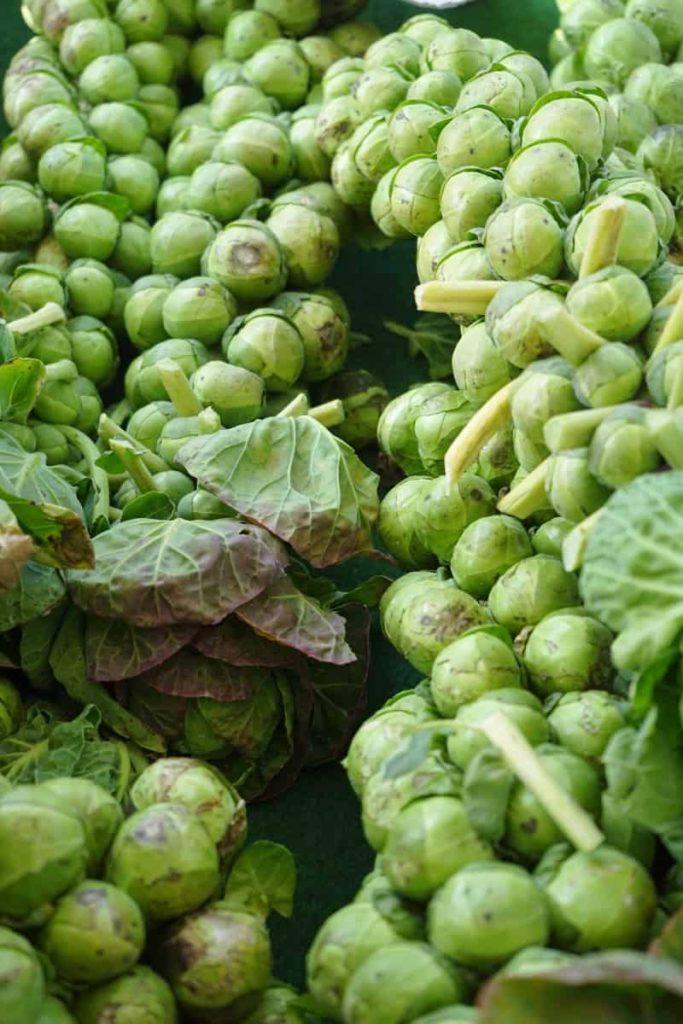Brussels’s sprouts are cole crops or cruciferous vegetables that belong to the Brassicaceae family. They belong to Broccoli, Cauliflower, and full-sized Cabbages, and the tiny heads resemble so much. They are cold-weather vegetables that have a long season and will continue to produce even after frost. Tall stalks can reach amazingly 3 to 4 inches long and are covered in broad green leaves.
A badly grown sprout is not a pleasure, but with healthy, fertile soil and a bit of love, you can grow delicious, crispy sprouts to be proud of, and there is no better-tasting Brussels Sprouts than homegrown. In addition, Brussels Sprouts need well-draining soil and do not need many nutrients, making them easy a crop to grow and perfect for beginners.
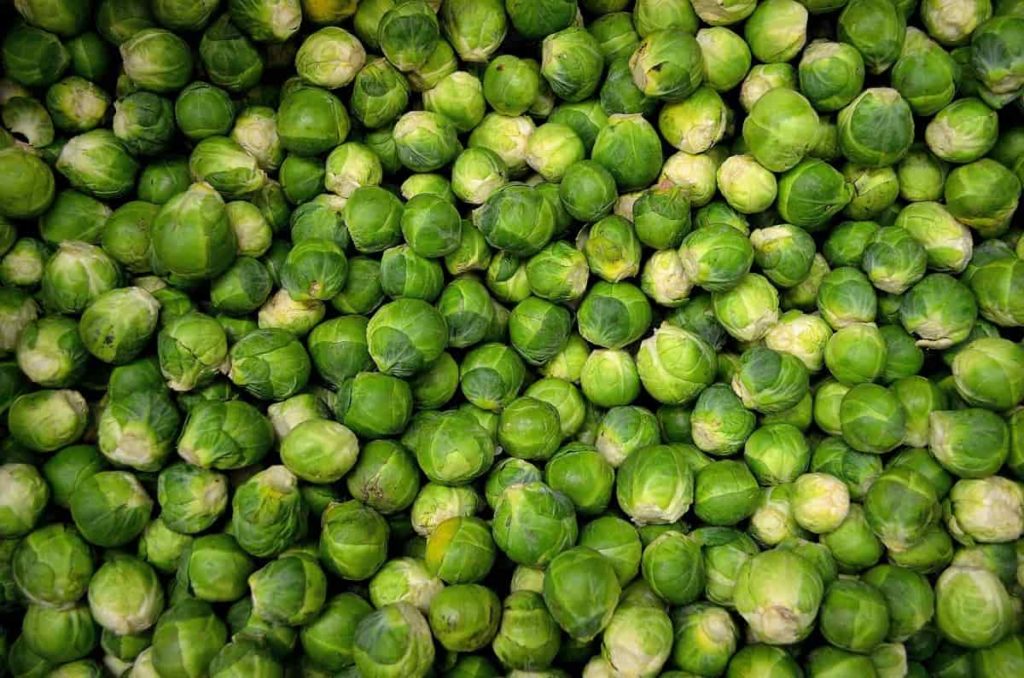
How to grow Brussels Sprouts from seed to harvest
How long do Brussel Sprouts take from seed to harvest?
- Brussels Sprouts are leggy plants that bear cabbage-shaped buds called sprouts or heads.
- Brussels sprout is a slow-growing but very bountiful crop. They require a long, cold growing season. Time is essential when planting and growing Brussels Sprouts.
- Growing Brussels Sprouts is not difficult but requires patience as it takes about four months for the plants to go from seed to harvest.
- Brussels Sprouts require a fairly long growing season (80 to 100 days for harvesting) and are a cold-season crop, which means they produce best when grown for a fall or early winter harvest.
How many Brussel Sprouts can you get from one plant?
- You can get as many as 50 sprouts in ideal growing conditions per plant. Brussels Sprouts are most flavorful when they mature in cold weather and have gone through a couple of frosts.
- The Brussels Sprouts produce food in their first year and flowers the following year. After all its sprouts have been harvested, you can continue to grow a Brussels sprout plant for seeds, but not for more sprouts. A full-sized healthy plant can bear 1 to 1.3 kg of sprouts.
- As long as the plant form sprouts, you can continue harvesting. The plant will eventually bolt as the weather worsens and no longer produces buds.
What month do you plant brussel sprouts?
- Most gardeners transplant young Brussels sprout plants into the garden in late spring, once the soil is warmed to about 16°C. If you’re planting seeds, you can instruct yourself to sow seeds in the spring and then plan a late fall harvest.
- Sow under cloches or fleece or in a cold frame from early March to early April. Start them early to get the best crop. Use early, mid-season, and late cultivars to provide a longer harvest season. For the early crop, sow in the greenhouse in small pots or modular trays in February for harvesting from August.
- A slow, long-growing crop, you should plant Brussels Sprouts in early spring or mid-to-late summer for a crop that matures in the fall. Small heads mature best even in cold and light frosty weather. Spring plantations are also fine in cooler climates
- Brussels Sprouts are best as a fall crop with a long growing season that starts six months before your first fall frost. You can also plant Brussels Sprouts in early spring, but sprouts that ripen in the heat get less taste than those that ripen after a light frost.
In case you missed it: 19 Common Brussels Sprouts Plant Problems: How to Fix Them, Solutions, and Treatment
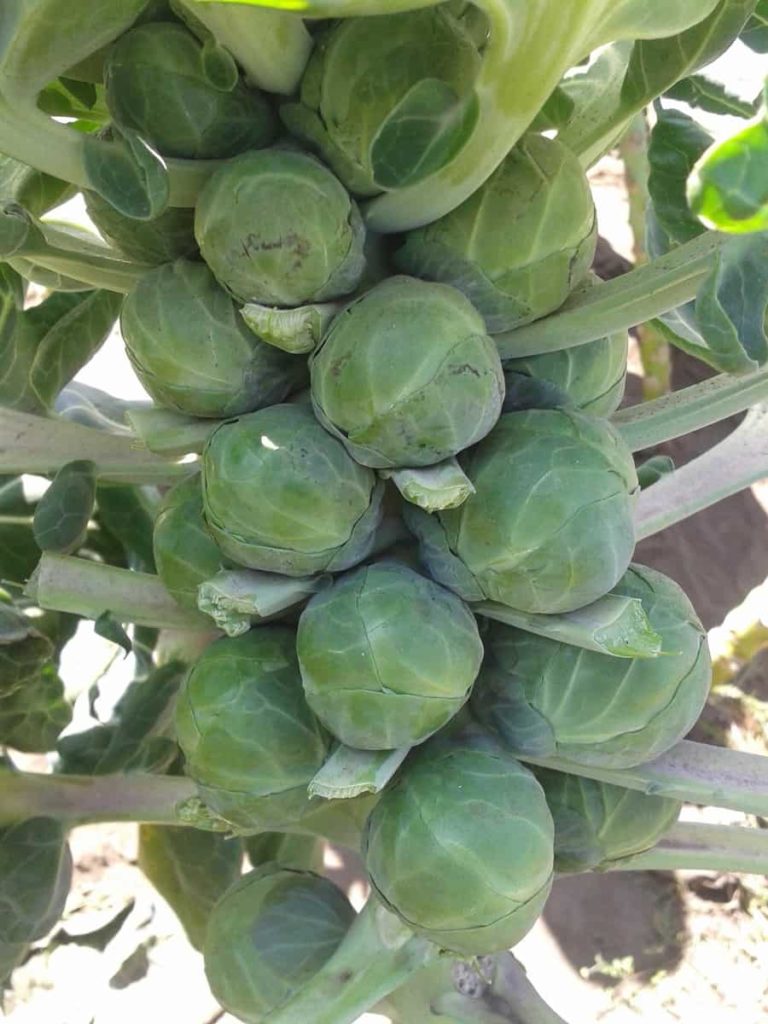
What month do you harvest Brussel sprouts?
- Sowing Brussels sprout seeds about four months before your first fall frost date. Start seeds from early to mid-summer in areas with cold winters, where winter temperatures are often below freezing.
- These plants need a long time to mature, sometimes more than 100 days, depending on different varieties, so patience is key. You may want to pick them up before the buds start to turn yellow and begin to bloom. Their diameter should be strong, bright green, and about 1 to 1.5 inches. You don’t have to harvest all the sprouts at the same time.
How do I know when to pick my Brussel Sprouts?
- Brussels Sprouts are ready to harvest when small heads are strong, green, and 1 to 2 inches in diameter. Twist them and remove the sprouts until they are separated from the plant. As soon as you remove the lower sprouts, you can also remove the yellow leaves; the plant continues to grow upwards, causing more leaves and sprouts.
- Brussels Sprout’s picking should begin when the sprouts are one inch in diameter. Brussels Sprouts are best harvested when they mature in cooler weather. The lower sprouts will mature first, and the upper sprouts will mature after a day to a few days.
- Brussels Sprouts mature from the bottom to the top of the plant, so the lower ones develop first. When harvesting, start picking those lower on the stalk and doing your work upwards. Twist or stick the buds, or cut them with a knife at the base where the sprouting meets the stem.
Will Brussel Sprouts produce the second year?
- No, Brussels Sprouts does not come back every year. They’re a biennial, which means they’ve only lived for two years. So, while the plant can survive for more than a year, in another, it will produce flowers and seeds rather than edible heads.
- Brussels Sprouts don’t return yearly, but it’s two years of their natural life cycle. If your area temperatures don’t drop below about -10°C, you may be able to enjoy fresh sprouts from the same plant for two years.
- Brussels Sprouts are biennials, and their life cycle is two years long, i.e., in the first year, they produce plants and sprouts, and in the second, they produce a small number of sprouts and go to seed.
Do Brussel Sprouts need full sun?
- The Brussels Sprouts thrive well in full sunshine and rich and permanently moist soil. Since Brussels Sprouts and other plants of the cabbage family are susceptible to a wide range of soil-borne diseases, it is a good idea to roam different garden areas every season.
- Brussels Sprouts thrive in areas where it’s cold and frosty winters. Plants grow well in soil and are satisfied in sunlight or partial shade but prefer partial shade. Sprouts mostly tolerate soil conditions but dislike acidic soils that can make the plant susceptible to a disease called club root.
- They thrive in temperatures between 8°C to 23°C and can survive up to -6°C in a short period. One or two light frosts can improve the taste of sprouts and make them sweeter.
- In arid and semi-arid areas, temperatures rise from 43.5°C to 49°C and fall below freezing in winter. While Brussels Sprouts like cold weather, they become fluffy and soft if temperatures are above 26.6°C. They are also attacked by aphids, while sprouts thrive in hot weather. Brussels Sprouts perform best in the full sun, at least six hours of direct sun.
In case you missed it: Best Fertilizer for Brussels Sprouts: Organic, Homemade, Compost, NPK, Liquid, Natural, When and How to Apply
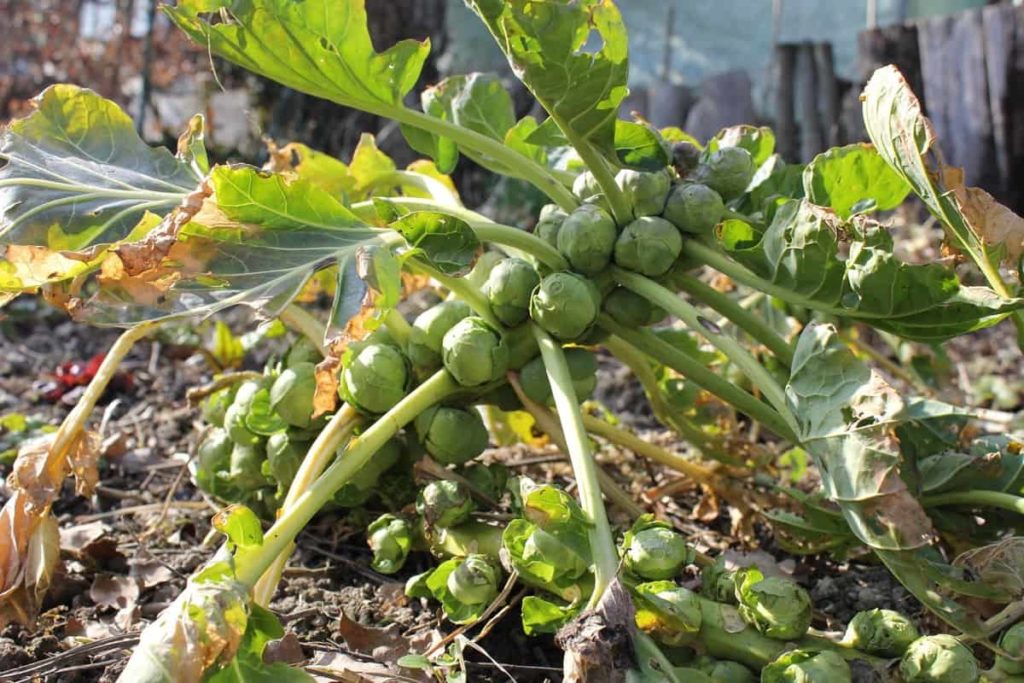
Should I pull Brussel Sprouts leaves?
- The leaves are edible and as delicious as sprouts. You can remove two or three additional leaves each week, but you must always hold many of the largest, healthiest, fully expanded upper leaves above to continue feeding the plant. Another practice is to top up or cut the plant’s growing tip when the sprouts are present but immature.
- Sprouts are ready to harvest when heads are 1 to 2 inches across, strong, and green. This also happens when the Brussels Sprouts leaves have to be pruned, as you remove the lower sprouts. Remove any yellow leaves to allow the plant to spend all its energy on producing new sprouts and leaves.
- The best time to prune the tops is from late August to mid-September, or three weeks before the first harvest. The reason for doing so is to send the plant’s remaining energy to size its sprouts and produce new leaf growth.
How often should you fertilize Brussels Sprouts?
- You should not allow Brussels Sprouts to dry completely, and feed them a high nitrogen liquid fertilizer every two to three weeks, only if needed.
- The best fertilizer for brussels sprout is 12-12-12, 16-16-16, and 20-20-20. However, if your plants are growing slowly or if your plants are green and lush, you may also want to consider low nitrogen fertilizer.
- Fertilize your Brussels sprout plants at least twice during the growing season. Once side-dress when the plants are about a foot tall. After that, you can fertilize every 3-4 weeks or every three weeks if it rains continuously. Aim for nitrogen-rich fertilizer, but try not to go overboard.
What causes Brussel Sprouts to bolt?
- There are many reasons for bolting, planting rooted seedlings, planting at the wrong time of the year, irregular temperatures (hot and cold), and unfavorable watering. Sow seeds in late spring (November) and plant seedlings in summer.
- When temperatures and daytime increase, annual leafy green vegetables like Lettuce will quickly send a stem with a flowering head on top.
- Bolting the Brussels sprout before sending the seed may or may not become buds. Once the seeds emerge, the plant stops growing. If the heads have already formed from the plant bolts, they can open, even if they are already compact.
What can you not plant next to Brussel Sprouts?
- Strawberry stops the growth of all cabbage plants, including Brussels Sprouts, as they compete for the same spot.
- You should not plant other cabbages like Cauliflower or Broccoli near Brussels Sprouts because they are in direct competition with many similar nutrients and resources, and their proximity will put them twice as much at risk from the same diseases and pests.
- Tomatoes and other nightshades, such as Brinjal, need many nutrients to grow. Brussels Sprouts are also heavy feeders, so the two should not be put together because they will compete for the same nutrients.
When should I start Brussel Sprouts indoors?
- Brussels Sprouts should be started indoors four weeks before your last frost date. It is a long-season crop planted for the fall harvest in the spring.
- If you have a place that receives enough sunlight, it’s possible to add Brussels Sprouts indoors. Brussels Sprouts need 6 hours of direct sunlight.
- Starting Brussels sprout seeds indoors under grow lights can give you a healthy head start before the plants move to the garden.
Why are my Brussel Sprouts not producing?
- Brussels Sprouts require water in dry spells every 14 days, and even and consistently moist soil is needed during their growing season, especially when developing sprouts. If your plants aren’t producing many sprouts, you may want to notice a lack of nitrogen in your soil.
- Check soil moisture regularly and give the plants 1 to 1.5 inches of water weekly. Encourage an abundant harvest by regularly feeding Brussels Sprouts with a feed of continuously released plant food. Lay a 3-inch layer of mulch to maintain soil moisture and prevent weeds. Harvest when the heads are firm and green.
How long does it take for Brussel Sprout seeds to germinate?
- Soaking Brussels Sprouts is not necessary, but it always has a better germination rate, so you should soak them for 12 to 24 hours before planting them.
- Growing Brussels Sprouts are relatively easy and take up very little space in the garden. They have to start indoors four weeks before your last frost date. It is a long-season crop planted for the fall crop in the spring.
- You should sow Brussels Sprouts in a modular seedlings tray and plant them four weeks later. You should sow one seed per module at a depth of 2 centimeters in a plant tray. Brussels Sprouts take 7 to 12 days to germinate and be ready for planting after about four weeks.
In case you missed it: Growing Brussels Sprouts Hydroponically – Full Guide
How often do you water Brussel Sprouts?
- You should water Brussels Sprouts deeply and frequently while maintaining the soil’s moisture. About 1 to 2 inches of water is needed every week. If possible, to conserve water, use drip irrigation. Applying mulch around the plant also helps save soil moisture and reduce the growth of weeds.
- If growing Brussels Sprouts in hot weather, be sure to water the plants well. Brussels Sprouts should get about 1 to 1 and 1/2 inches of water per square foot per week.
- The seedlings should be watered once or every other day, depending on how much sunlight and heat they get.
How far do you plant Brussel Sprouts apart?
- Brussels is traditionally sown in a separate seedbed rather than on the main vegetable plot; once more space is available, then transplanted in early summer. Sow the seeds thinly, 1/2 inches deep, 6 inches in rows. Once they are large enough to handle 3 inches from the thin seedlings.
- Brussels Sprouts get bigger, so they need to be about 18 to 24 inches apart in a row or bed. Space rows give themselves enough space to walk at a distance of 30 inches if placed in rows. Don’t let the seedlings sit for too long, don’t dry, or get stunted in their pack.
- Sow seeds about 1/2 inch deep. If sown directly outdoors, sow seeds at a distance of about 2 to 3 inches.
Why are my Brussels Sprouts so small?
- Since the time required for Brussels Sprouts is so long, and the temperature necessary for proper growth is so narrow, problems often occur in growing Brussels Sprouts. One of the problems is that when the plant leaves become loose, poorly formed heads. However, various plantation techniques and Brussels sprout cultivars are known to yield large sprouts to achieve a large sprout.
- Allow about 28 to 30 inches between the plants to get larger sprouts from your Brussels sprout planting. The harvesting period is longer with larger sprouts.
How do you encourage Brussel Sprouts?
- Light pruning of Brussels sprout plants will encourage vigorous and further sprout growth, allowing them to give more sprouts. Start harvesting the Brussels Sprouts when you see at least one sprout developing. At this point, prune at least six to eight leaves with hand pruners.
- Encourage an abundant harvest by regularly feeding Brussels Sprouts with a feed of continuously released plant food. You should keep a 3-inch layer of mulch to maintain soil moisture and prevent weeds. Harvest when the heads are strong and green.
How do I keep worms off my Brussel Sprouts?
- Aphids prefer to live on new leaves or flowers or in protected areas like your Brussels Sprouts. They’re easy enough to manage in a vegetable garden, spray them with a hard stream of water to drop them off the plants or spray them with insecticidal soap.
- Several insects, from cabbage worms to grasshoppers, will quickly devour unprotected Brussels sprout seedlings. Lightweight garden fleece or row covers protect the plants as they soak up the summer heat, an essential factor in preparing a good crop.
- You’ll check under the leaves regularly. Look for damage to egg masses, stems and leaves, and worms. Pick them up by hand, crush them, or put them in soapy water to kill them. Spray homemade pesticide soap solutions to repel or kill insects.
- Spray homemade insecticidal soap to repel or kill insects with one tablespoon of cooking oil and two tablespoons of baking soda, and add a few drops of ivory soap to 1 quart of water. In addition, you can spray biocontrol agents such as Bacillus thuringiensis, or Spinosad.
In case you missed it: Brussels Sprouts Growing Tips in the Backyard
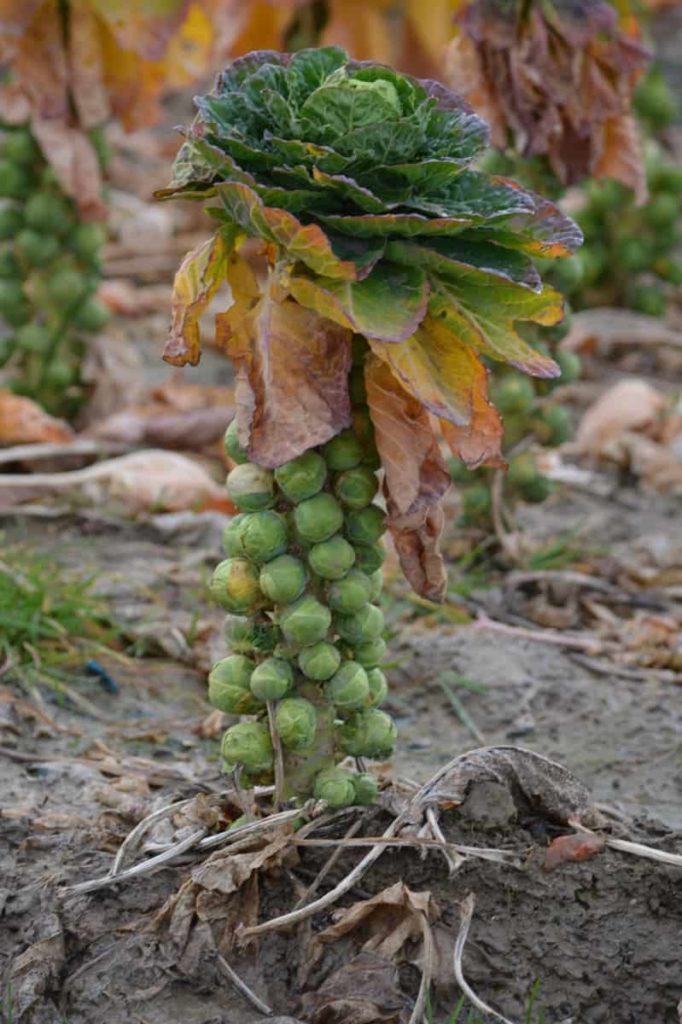
Can you grow Brussel Sprouts in pots?
- Brussels Sprouts can be grown in pots, provided they have enough space. A container must be 12 inches in diameter, with soil at least 12 inches deep. A large pot from the nursery tree is a good container, or a 5-gallon bucket will also work well.
- Planting Brussels Sprouts in containers can grow the harvest longer, as the containers can be brought into the root basement or cupboard indoors. This will keep you harvesting them well in the winter, and it’s an old-time trick to root-cellaring Brussels Sprouts.
Can you harvest Brussel Sprouts in winter?
- Most gardeners know that Brussels Sprouts prefer cooler temperatures, but these small common cabbages take the concept of cold-season gardening to the next level. You can grow a fresh crop during the winter with the right care.
- You don’t give up on your winter harvest dreams in cold places. There are ways to create a slightly warmer microclimate in your garden or provide winter protection for your crops.
What soil is best for Brussel Sprouts?
- Raised beds are especially recommended for cold-season vegetables, especially in spring and fall, when temperatures are not consistent.
- Brussels sprouts need space to spread, so they are spaced 18 to 24 inches apart in an area that daily receives 6 to 8 hours of sunlight and has well-drained, fertile soil with a pH of 6.8. Before planting, you should improve the soil by mixing several inches of compost or other organic matter.
In case you missed it: How to Start Home Gardening in New Mexico (NM) for Beginners: From Scratch for Indoors, Outdoors, Backyards, Raised Beds, and Containers
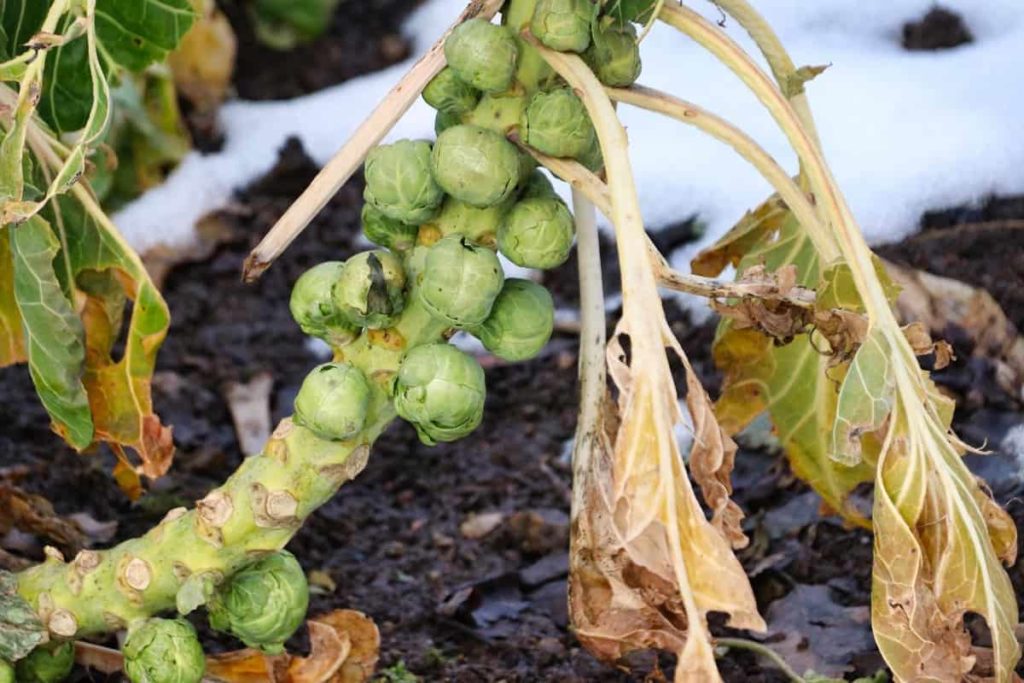
Conclusion
Brussels sprout has become a favorite winter vegetable. If you want to cook with these vegetables, you can buy fresh or frozen Brussels Sprouts from the store, but it’s not as rewarding as growing your own and bringing them from the garden to the table. Regardless of the variety, the right conditions are essential to ensure that your seeds are made for you to harvest for dinner to enjoy them. Knowing how long it takes for Brussels Sprouts, temperature, soil conditions, pests and diseases are all essential factors to keep in mind for a successful harvest.
- How to Grow Hibiscus from Flower
- Plantation Ideas for Home Decoration: A Beginners Guide
- Flower Garden Designs and Layouts for Beginners
- Planting and Spacing Techniques in Papaya: A Beginner’s Guide
- Growing Gold: Essential Techniques for Planting Pineapples
- How to Make Kalanchoe Plant Bushy: Home Remedies and Solutions
- 11 Reasons Why Your Gardenia is Not Blooming: Home Remedies and Solutions
- Eco Elegance: The Guide to Designing a Drought-Tolerant Landscape
- Gardening on a Slope: Strategies for Hillside Landscaping
- Nourish and Flourish: Top Organic Mulches for Thriving House Plants
- Everything You Want to Know about Indian Mogra Flower: Discover Uses and Growing
- Green Thumb Success: Expert Tips for Cultivating Greenhouse Pumpkins All Year Round
- Maximize Growth & Flavor: The Ultimate Guide to Companion Planting in Herb Gardens
- How to Control Rhododendron Problems Naturally: Home Remedies and Organic Ways to Fix Them
- Natural Magic: The Remarkable Benefits of Cinnamon for Plants
- Best Steps to Revive Dying Tulip with Natural and Organic Treatment
- 10 Reasons Why Your Angel Trumpet is Not Blooming: Remedies and Treatment
- How to Fix Periwinkle Leaf and Flower-Related Problems: Natural Remedies and Solutions
- How to Fix Zinnias Leaf and Flower Problems: Discover Natural and Home Remedies
- Organic Steps to Induce Lemon Tree Flowers: A Comprehensive Guide
- Bloom Booster: Crafting the Perfect Homemade Bougainvillea Fertilizer
- Optimizing Growth: A Guide to Applying NPK Fertilizer for Potted Plants
- 10 Best Homemade Fertilizers for Rubber Plant: DIY Recipes and Application Method
- How to Boost Female Pumpkin Flowers: Effective Steps for More Flowers and High Yields
- Transform Your Indoor Garden: Top Benefits of Pink Salt for Houseplants
- 10 Best Homemade Fertilizers for Peacock Plants (Calathea): Easy DIY Guide
- Unlock Blooms: 9 Reasons Why Your Potted Chrysanthemum is Not Blooming
- 8 Reasons Why Your Potted Hibiscus is Not Blooming: Fix it with Simple Solutions
- Unlock Blooms: 9 Key Reasons Your Potted Frangipani Won’t Flower
- 10 Reasons Why Is My Ice Plant Not Blooming: Remedies and Treatment
- 10 Reasons Why My Potted Hydrangea Not Blooming: Treatment and Remedies
- 10 Reasons Why is My Wisteria Not Blooming: Remedies and Treatment
- 10 Reasons Why is My Goldfish Plant Not Blooming: Remedies and Treatment
- Maximize Your Space: Ultimate Guide to Balcony Gardening with Grow Bags
- 10 Reasons Why Your Iris is Not Blooming: Remedies and Treatment
- 10 Reasons Why Your Anthurium Plant is Not Blooming: Treatment and Remedies
- 10 Reasons Why Your Aquaponic Plants Are Not Flowering: Remedies and Treatment
- 10 Reasons Why Your Agapanthus is Not Flowering: Remedies and Treatment
- Ultimate Guide to Brown Turkey Fig: Steps to Growing Brown Turkey Figs
- How to Grow Acai Berry: Propagation, Planting, and Care
- Ultimate Guide to Growing Satsuma Plum: Exploring Planting, Pruning and Care
- 10 Reasons Why Your Plant Buds are Falling off: Prevention and Remedies
- Nourish to Flourish: The Best NPK Ratio for Houseplants
- Ultimate Guide to Mexican Bird of Paradise: Explore from Propagation to Planting and Care
- Ultimate Guide to Devils Backbone Plant: Explore from Propagation to Planting and Care
- Ultimate Guide to Troubleshooting Seed Starting Problems
